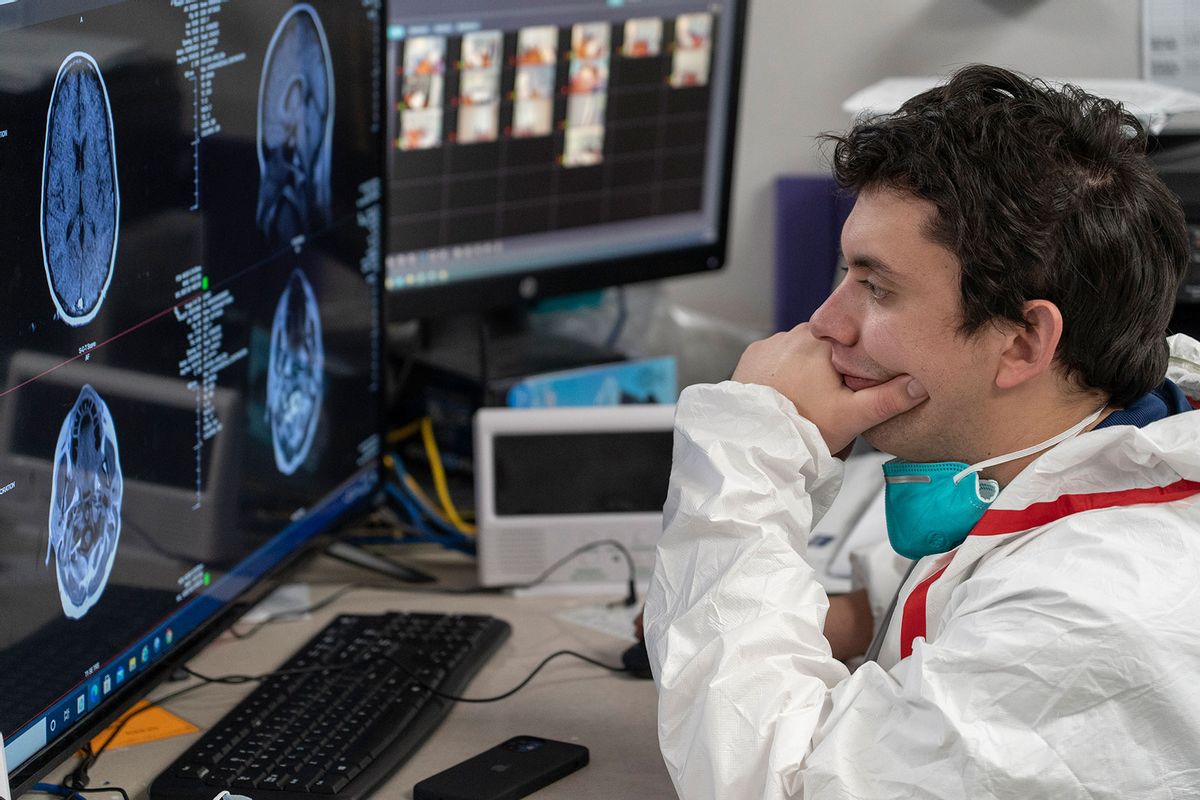Understandably, COVID-19 is largely thought of as a respiratory illness. Its most notorious symptoms include coughing, congestion and a sore throat, and people can limit its spread by covering their noses and mouths with masks. Yet as many people know from experience, COVID-19 can do a lot more than hurt the lungs and throat. It also wreaks havoc on the heart, the gut and the nervous system.
That's because COVID-19 is primarily a vascular disease, with the SARS-CoV-2 virus targeting the vascular endothelium that transmits fluids between blood and other bodily tissues. This specialization is what helps it spread so easily throughout the body. Consequently, it isn't surprising that COVID-19 also infects our most important organ of all: the brain.
Two of the brain injury markers (GFAP and Nfl) are "significantly higher in participants with neurological complications."
The outstanding question is, if COVID can affect the brain, how bad is the damage? Dozens of researchers from the University of Liverpool and King’s College London, among other scientific institutions, found that recovering COVID-19 patients may show up as healthy on the usual blood inflammation tests — and yet still have markers of brain injury in their blood. Their analysis was recently published in Nature Communications.
"Compared to 60 uninfected controls, [markers of brain injury] are increased with COVID-19 infection at acute timepoints," explain the study's authors, adding that two of the brain injury markers (GFAP and Nfl) are "significantly higher in participants with neurological complications."
When there are higher level of markers like these in the blood, they can indicate the presence of serious neurological conditions like strokes, seizures and brain inflammation, as well as milder ones like headaches and myalgia.
“Our study shows that markers of brain injury are present in the blood months after COVID-19, and particularly in those who have had a COVID-19-induced brain complication (e.g. inflammation, or stroke), despite resolution of the inflammatory response in the blood," Professor Benedict Michael, principal investigator and director of the University of Liverpool’s Infection Neuroscience Laboratory and co-author of the study, said in a statement. "This suggests the possibility of ongoing inflammation and injury inside the brain itself which may not be detected by blood tests for inflammation."
To study this, the researchers examined blood samples from over 800 COVID-19 patients who had been hospitalized in England and Wales — of whom half had developed neurological conditions. It was a rigorous study, one that extended to the period after patients were discharged from the hospital and exhibited fewer or no symptoms. Much to the scientists' surprise, the brain injury markers persisted in the patients' blood for months after their release.
Just as concerning, as this study showed, this damage may not always appear on routine tests. But the good news is this research brings us closer to finding the mechanisms behind brain damage caused by SARS-CoV-2 and — perhaps more importantly — could lead to ways of treating it. "These brain injury markers are associated with dysregulated systemic innate and adaptive immune responses in the acute phase of the disease, and suggest that these may represent targets for therapy," the authors concluded.
Want more health and science stories in your inbox? Subscribe to Salon's weekly newsletter Lab Notes.
"This suggests the possibility of ongoing inflammation and injury inside the brain itself which may not be detected by blood tests for inflammation."
The Nature Communications study is only the latest in a series of scientific papers demonstrating that COVID-19 causes harm to the brain. In June scientists led by Dr. Alexander Wong at the University of Waterloo used correlated diffusion imaging (an updated form of MRI scanning) to study the brains of COVID-19 patients. They discovered that these patients suffered immediate changes to the white matter in two areas of their brains: Their frontal lobes, which help manage thoughts, and in their cerebellums, which take charge of motor control.
"Hopefully, this research can lead to better diagnoses and treatments for COVID-19 patients," Wong told Salon at the time. "And that could just be the beginning for CDI as it might be used to understand degenerative processes in other diseases such as Alzheimer's or to detect breast or prostate cancers."
In a somewhat similar vein, researchers at the University of Oxford published a paper in the journal Nature in 2022 demonstrating that even mild COVID-19 infections can shrink the brain. After studying 785 patients between the ages of 51 and 81 both before and after the pandemic — more than half of whom developed COVID-19 — the scientists found that the COVID-19 patients had more gray matter shrinkage, especially in the areas of the brain linked to smell. Additionally, they found that 1.8% of the parahippocampal gyrus and 0.8% of the cerebellum had shrunk compared to patients who were not COVID-19 positive.
"Despite the infection being mild for 96 per cent of our participants, we saw a greater loss of grey matter volume, and greater tissue damage in the infected participants, on average 4.5 months after infection," Professor Gwenaëlle Douaud, lead author on the study, said in a press statement at the time. "They also showed greater decline in their mental abilities to perform complex tasks, and this mental worsening was partly related to these brain abnormalities."
A 2022 study in the journal Molecular Psychiatry further unpacked how the SARS-CoV-2 virus messes with the human brain. It revealed that the virus triggers the same inflammatory processes seen in patients with Alzheimer's or Parkinson's. One of the study's authors, Dr. Albornoz Balmaceda, compared the inflammation to a "fire" in the brain, an example of the body's natural processes misfiring and causing harm instead of health. "It's kind of a silent killer, because you don't see any outward symptoms for many years," Balmaceda said in a press release.



Shares